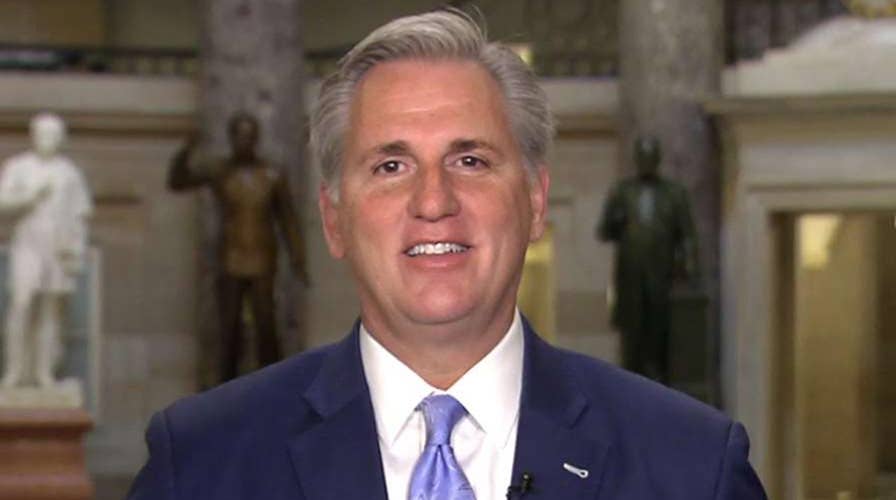House, Senate GOP set to hammer out differences on tax plan
Rep. Kevin McCarthy speaks out on efforts to find common ground to get a bill to the president's desk.
The Senate passed its version of tax reform early Saturday morning, following in House Republicans’ footsteps.
But the two plans differ and both chambers of Congress will have to come together to create a unified piece of legislation before it can be sent to President Trump.
Here’s a look at how the Senate and House versions of tax reform compare.
Alternative minimum tax
The alternative minimum tax (AMT) is a supplemental income tax levied on certain taxpayers. The tax is meant to offset benefits a person with a high income could receive. It also ensures taxpayers pay a minimum tax, according to the IRS.
The AMT has often been criticized because it has not been adjusted for inflation over the years and has hit more households than originally intended, tax experts have said.
Senate: Due to a revision to the legislation that was ultimately passed, the Senate’s plan leaves the AMT in place. However, the amount of income exempt from it is raised under the revised bill.
House: The House plan would repeal both the individual and corporate alternative minimum tax.
Current: The current plan imposes the AMT on taxpayers whose tentative minimum tax is higher than the regular tax.
Child tax credit
Raising the child tax credit was an initiative pushed for by Ivanka Trump, the president's daughter and adviser.
Senate: The Senate measure drastically increases the current per-child tax credit to $2,000.
House: The House plan, which has been largely criticized by Sen. Marco Rubio, R-Fla., would raise the child tax credit to $1,600.
Current: The current tax code allows for taxpayers to receive up to $1,000 per child under the age of 17.
Corporate tax rate
Lowering the corporate tax rate is a major priority for Trump and his administration. He has said that lowering it to 20 percent is his “red line.”
Senate: The Senate plan would lower the corporate tax rate to 20 percent with a delayed implementation of one year.
House: Under the House measure, the corporate tax rate would be lowered to 20 percent.
Current: The corporate tax rate is currently 35 percent.
Estate tax
The federal estate tax is a tax on the transfer of property after someone’s death. That property must exceed a certain value amount for the tax to be applicable. Only the wealthiest 0.2 percent of estates owe any estate tax, according to IRS data.
It is sometimes referred to as the “death tax” by opponents.
Senate: Under the Senate plan, the estate tax would remain, but the exemption would be doubled.
House: The House plan would double the estate tax exemption to $11 million for individuals and $22 million for couples. However, it would also repeal it after 2023.
Current: Estates valued at more than $5.4 million in 2017 could be taxed here.
Individual mandate
The individual mandate is the ObamaCare requirement to purchase health care. The Congressional Budget Office predicted that repealing the mandate could reduce federal deficits by about $338 billion over the next 10 years. It would also increase the number of uninsured Americans by about 13 million people in that same time span.
Senate: The Senate bill would eliminate the individual mandate.
House: Changes to the individual mandate were not included in the House measure.
Current: Americans who do not purchase health care but could afford to do so could face a fine, according to the federal government’s health care website. Taxpayers could face a fine of either 2.5 percent of the household income or a per-person fee – whichever is higher.
Pass-through provisions
Provisions for “pass-through” businesses shaped up to be one of the greater fights among lawmakers in the tax reform debate.
A pass-through business is one that is not a corporation and, therefore, isn’t taxed as such. These include sole proprietorships, joint ventures, limited liability companies and S corporations. Millions of American businesses use the pass-through taxation format, where the profits are counted in the owners’ personal tax returns.
Senate: The Senate measure sets up a new deduction of 23 percent for those who qualify for pass-through taxation. The plan also makes it simpler for taxpayers to obtain this deduction; however, it would expire after 2025.
House: The House plan reduces the tax to 25 percent. It also creates a 9 percent rate for the first $75,000 in earnings for some smaller pass-throughs.
Current: Pass-through businesses are subjected to the federal income tax, with a top rate of 43.4 percent, according to the Tax Foundation think tank.
Standard deduction
Standard deduction refers to the deduction of the amount of income Americans are taxed. Republicans say this provision will be a net benefit for most tax filers.
Senate: The Senate would increase the standard deduction to $12,000 for individual filers and $24,000 for married couples.
House: The House measure would increase the standard deduction to $12,000 for individual filers and $24,000 for married couples.
Current: The current standard deduction rate is $6,350 for individual filers and $12,700 for married couples.
State and local tax deductions
State and local tax (SALT) deductions refer to the amount Americans in high-tax states – particularly blue states such as New York and California – are able to write off. Several Republican lawmakers from these states have expressed concern.
Senate: The Senate plan would repeal SALT deductions when it comes to income and sales tax. However, it would leave in place a provision for property tax deductions up to $10,000.
House: Like the Senate, the House would eliminate all SALT deductions expect for a property tax deduction capped at $10,000.
Current: Taxpayers who itemize their deductions are able to deduct four kinds of non-businesses taxes, including state and local income, real estate, property and sales taxes.
Tax brackets
One of the ways Republicans and the White House have tried to peddle their tax overhaul plan is to promise to make it simpler for tax filers – including with just how they file.
Senate: The Senate measure would keep the number of personal income tax brackets at seven, although it would change the rates to 10, 12, 22, 24, 32, 35 and 38.5 percent.
House: The House plan shrinks the number of tax brackets to four with rates of 12, 25, 35 and 39.6 percent.
Current: There are currently seven tax brackets for filers with rates of 10, 15, 25, 28, 33, 35 and 39.6 percent.
The Associated Press contributed to this report.





